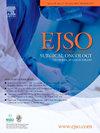Short-term outcomes of transanal endoscopic intersphincteric resection for locally advanced rectal cancer after neoadjuvant chemoradiotherapy: A single-center retrospective cohort study
IF 3.5
2区 医学
Q2 ONCOLOGY
引用次数: 0
Abstract
Objective
To compare the perioperative safety and specimen characteristics after transanal endoscopic intersphincteric resection (taE-ISR) versus classical intersphincteric resection (cISR) in patients with locally advanced rectal cancer (LARC) treated with neoadjuvant chemoradiotherapy (nCRT).
Methods
Clinicopathological data of 145 patients (75 undergoing taE-ISR and 70 undergoing cISR after nCRT) were retrospectively analyzed. Baseline characteristics, perioperative details, and pathological specimen quality of the two groups were compared.
Results
Intraoperative blood loss was lower in the taE-ISR group compared to cISR (50.0 (40.0–100.0) ml vs. 70.0 (50.0–100.0) ml, P = 0.034). Two patients (2.6 %) in the taE-ISR group and eight patients (11.4 %) in the cISR group sustained adjacent organ injury (P = 0.037). There was no statistically significant difference in the prevalence of postoperative complications between the two groups (17.3 % vs. 30.0 %, P = 0.072). However, pelvic abscess (1.3 % vs. 8.6 %, P = 0.042) and rectovaginal fistula (0.0 % vs. 5.7 %, P = 0.036) occurred less often in taE-ISR compared to cISR. The complete resection rate was higher in taE-ISR compared to cISR (98.7 % vs. 91.4 %, P = 0.042). No patients in taE-ISR had positive distal resection margins (DRM), while four patients in cISR had positive DRM (0.0 % vs. 5.7 %, P = 0.036).
Conclusion
taE-ISR after nCRT was associated with higher-quality specimens, reduced intraoperative blood loss, and fewer perioperative complications, attesting to the feasibility and safety of taE-ISR In low-LARC patients.
经肛门内镜括约肌间切除术治疗局部晚期直肠癌新辅助放化疗后的短期疗效:一项单中心回顾性队列研究
目的比较局部晚期直肠癌(LARC)新辅助放化疗(nCRT)经肛门内镜下括约肌间切除术(taiisr)与经典括约肌间切除术(cISR)的围手术期安全性和标本特征。方法回顾性分析145例患者的临床病理资料,其中75例行taE-ISR, 70例行cISR。比较两组患者的基线特征、围手术期细节及病理标本质量。结果taE-ISR组术中出血量低于cISR组(50.0 (40.0 ~ 100.0)ml vs. 70.0 (50.0 ~ 100.0) ml, P = 0.034)。taE-ISR组2例(2.6%)患者和cISR组8例(11.4%)患者发生邻近器官损伤(P = 0.037)。两组术后并发症发生率比较,差异无统计学意义(17.3% vs 30.0%, P = 0.072)。然而,与cISR相比,taE-ISR中盆腔脓肿(1.3%对8.6%,P = 0.042)和直肠阴道瘘(0.0%对5.7%,P = 0.036)的发生率较低。与cISR相比,taE-ISR的完全切除率更高(98.7%比91.4%,P = 0.042)。taE-ISR中没有患者的远端切除边缘(DRM)阳性,而cISR中有4例患者的DRM阳性(0.0%比5.7%,P = 0.036)。结论nCRT术后taE-ISR标本质量较高,术中出血量减少,围手术期并发症较少,证明了taE-ISR在低larc患者中的可行性和安全性。
本文章由计算机程序翻译,如有差异,请以英文原文为准。
求助全文
约1分钟内获得全文
求助全文
来源期刊

Ejso
医学-外科
CiteScore
6.40
自引率
2.60%
发文量
1148
审稿时长
41 days
期刊介绍:
JSO - European Journal of Surgical Oncology ("the Journal of Cancer Surgery") is the Official Journal of the European Society of Surgical Oncology and BASO ~ the Association for Cancer Surgery.
The EJSO aims to advance surgical oncology research and practice through the publication of original research articles, review articles, editorials, debates and correspondence.
 求助内容:
求助内容: 应助结果提醒方式:
应助结果提醒方式:


